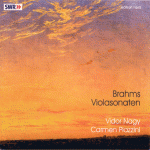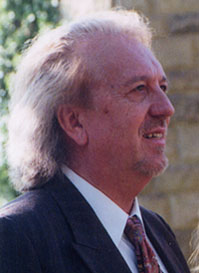 Brahms: Viola Sonatas in f, op. 120/1; in Es, op. 120/2;
Brahms: Viola Sonatas in f, op. 120/1; in Es, op. 120/2;
Vidor Nagy, Viola, Carmen Piazzini Klavier;
HERA 02112. (43:59)
Autumnal is a word often used to describe Brahms’ later works. In the case of these two sonatas, we are well past the equinox, closer to December, I would say, than to October (for those who may be reading this south of the equator, that’s closer to June than to April). The leaves have already turned, and they’re falling oft the trees. Brahms would write only two more works following these sonatas, the Four Serious Songs, op. 121, and the Eleven Choral Preludes for organ, op. 122. The sonatas were originally conceived, not for viola and piano, but for clarinet and piano, the composer’s final tribute to his favorite clarinetist, Richard Mühlfeld. They were first played by Mühlfeld, with Brahms at the piano, on September 23, 1894, at the Villa Soletalp in Berchtesgaden. Brahms’s correspondence reveals that not long thereafter he was in contact with his violinist friend, Joseph Joachim proposing that he play the sonatas on the viola. These are certainly not the major revisions that so many of Brahms’s works underwent. Truth be told, they’re not even arrangements or transcriptions in the conventional sense. The tessitura and characteristic sound qualities of the clarinet and the viola are quite similar. Brahms felt, and rightly so, that these sonatas., with only the most minor adjustments to accommodate range (an octave transposition here and there), would be equally effective, as is, played on either instrument. And indeed they are. Melodically and harmonically they have much in common with the Two Songs for alto, viola, and piano, op. 91, so much so, in fact that one has the feeling that near quotations from the songs have found their way into the sonatas.
Versions of these works on the viola are available in great abundance, having been recorded by every “name” violist as well as a number of violinists who switched instruments just for the occasion. Recordings on viola are close to outnumbering those on clarinet. While I am personally familiar with several more recent releases (Yuri Bashmet, Nobuko Imai, Kim Kashkashian, Ulrich Koch, and Pinchas Zuckerman), one can also find historical recordings with Lionel Tertis and William Primrose, the latter partnered by William Kapell.
Any contender who enters this arena had better come armed with more than just his or her instrument in hand. I am delighted to report that Vidor Nagy has a great deal more to offer than just another run-of-the-mill performance. These are beautifully, I might even say lovingly, shaped and shaded interpretations. Nagy produces one of the most attractive viola sounds I’ve heard in a long time. What struck me as unusual, and highly desirable, was that his instrument and the tone he draws from it have that deep, dark, woody quality one expects on the C and G strings, but as the bow crosses over onto the A string and Nagy moves up the fingerbord into the higher registers, his viola seems to take on the lighter, more transparent sound of a violin. I regard this as a good thing, because the viola, like the cello, can often sound pinched and nasal in the higher positions. In contrast, as Nagy goes higher, his tone becomes sweeter, losing some of that viola readiness, but without sacrificing any of the power needed to project the line. I suspect that the actual instrument Nagy plays contributes in large measure to the sound he is able to draw from it. Really nice. I’m very impressed. But I must also add a word of praise for Carmen Piazzini, who accompanies Nagy here in one of those meetings of the mind and heart that brings the two voices into perfect harmony and balance. The results are very much helped by the recording itself, which has managed to bring the piano to the fore, or at least into exactly the same space as the viola, without engulfing it. Both parts are heard clearly, yet as one.
My only regret is the somewhat short playing time of the disc, just under 44 minutes. Heretofore, my favorite version of these sonatas played on the viola has been a CD from the German label, Bayer, played by violist Ulrich Koch and pianist Sachito Nakamura (BR 100 037). This disc sensibly includes the aforementioned Two Songs for alto, viola and piano op. 91, sung by Gabriele Preiser. Not only does this fill out the CD, but also it allows us to hear the intimate connections between the sonatas and the songs. It’s such a logical grouping, I don’t understand why it’s not done more often. In any case, the new entry from Nagy and Piazzini is simply too gorgeous to pass over because of skimpy timing. I’ve not seen this CD in local retail shops, so I don’t know what its distribution is like here in the US. But you can almost certainly obtain it by ordering direct from the source, www.editionhera.de.
Jerry Dubins
Übersetzung:
FANFARE MARCH / APRIL 2004 USA
 Brahms:Violasonaten in f op. 120/1; in Es op. 120/2;
Brahms:Violasonaten in f op. 120/1; in Es op. 120/2;
Vidor Nagy, Viola, Carmen Piazzini Klavier;
HERA 02112. (43:59)
Herbstlich ist das Wort. das oft benutzt wird, um Brahms‘ spätere Werke zu beschreiben. Im Falle dieser beiden Sonaten sind wir weit jenseits der Tag- und Nachtgleiche, ich würde sagen, näher beim Dezember denn Oktober (für jene, die dies südlich des Äquators lesen, näher zum Juni als April). Die Blätter haben sich bereits verfärbt und fallen von den Bäumen. Brahms wird nach diesen Sonaten nur noch zwei Werke schreiben, die Vier ernsten Gesänge op. 121 und die Elf Choralvorspiele für Orgel op. 122. Die Sonaten waren ursprünglich nicht für Viola und Klavier, sondern für Klarinette und Klavier gedacht, der letzte Tribut des Komponisten für seinen bevorzugten Klarinettisten, Richard Mühlfeld. Sie wurden von Mühlfeld, mit Brahms am Klavier, am 23. September 1894 in der Villa Soletalp in Berchtesgaden erstaufgeführt. Brahms‘ Korrespondenz ist zu entnehmen, dass er nicht lange danach mit seinem geigenden Freund Joseph Joachim in Verbindung trat und ihm vorschlug, die Sonaten auf der Viola zu spielen. Es sind dies gewiss nicht größere Revisionen, wie sie bei so vielen Werken von Brahms zu finden sind. Um die Wahrheit zu sagen, sie sind nicht einmal Arrangements oder Transkriptionen im herkömmlichen Sinne. Die Tessitur und die charakteristischen Klangqualitäten der Klarinette und der Viola sind recht ähnlich. Brahms fühlte, und zwar zu Recht, dass diese Sonaten mit nur geringfügigen Anpassungen an den Tonumfang (eine Oktavtransposition da und dort) auf beiden Instrumenten gleichermaßen wirksam gespielt werden können. Und so ist es in der Tat. Melodisch und harmonisch haben sie viel gemeinsam mit den Zwei Gesängen für Alt, Viola und Klavier op. 91, so sehr, dass man das Gefühl hat, dass Beinahe-Zitate aus den Liedern den Weg in die Sonaten gefunden haben.
Versionen dieser Werke auf der Viola sind in Hülle und Fülle erhältlich, jeder namhafte Bratschist hat sie eingespielt, genauso wie eine Anzahl von Geigern, die gelegentlich zu diesem Instrument wechseln. Während ich persönlich einige neuere Aufnahmen (mit Yuri Bashmet Nobuko Imai, Kim Kashkashian, Ulrich Koch und Pinchas Zuckerman) kenne, kann man auch historische Aufnahmen mit Lionel Tertis und William Primrose – diese mit William Kapell ais Partner – finden.
Jeder Wettbewerber, der diese Arena betritt, muss mit mehr als bloß seinem oder ihrem Instrument in der Hand gerüstet sein. Ich freue mich berichten zu können, dass Vidor Nagy sehr viel mehr anzubieten hat als eine weitere Wald- und Wiesen-Aufführung. Dieses sind sehr schön, ich möchte sagen liebevoll geformte und abschattierte Interpretationen. Nagy produziert den anziehendsten Bratschenton, den ich seit langem gehört habe. Was mir als ungewöhnlich, aber höchst wünschenswert auffiel, ist, dass sein Instrument und die Töne, die er ihm entlockt, die tiefe und dunkle Qualität haben, die man auf der C- und G-Saite erwartet, aber wenn der Bogen auf die A-Saite überwechselt und Nagy das Griffbrett hinauf ins höhere Register steigt, scheint sein Instrument den leichteren und transparenteren Klang einer Violine anzunehmen. Ich halte dies für eine gute Sache, denn wie das Cello kann auch die Bratsche in höheren Positionen, gequetscht und nasal klingen. Im Gegenteil; wenn Nagy höher geht, wird sein Ton sanfter und verliert etwas den Rohrblatt-Charakter, ohne aber an der Kraft einzubüßen, die für die Nachzeichnung der Linien nötig ist. Ich vermute, dass das derzeitige Instrument, das Nagy spielt, in großem Ausmaß zu dem Klang beiträgt, den er daraus hervorzubringen imstande ist. Wirklich schön – ich bin sehr beeindruckt! Aber ich muss auch Lobesworte für Carmen Piazzini anfügen, die hier Nagy in jenem Zusammenstimmen von Verstand und Herz begleitet, die zwei Stimmen zu perfekter Harmonie und Ausgewogenheit vereinigt. Dieses Ergebnis wird auch sehr von der Aufnahmetechnik selbst gefördert, die es fertig gebracht hat, das Klavier in den Vordergrund, zum wenigsten aber in den gleichen Bereich wie die Viola zu bringen, ohne dass diese aber zugedeckt wird. Beide Parte sind klar und einheitlich zu hören.
Mein einziges Bedauern ist die kurze Spielzeit der CD, knapp unter 44 Minuten. Bislang war meine, bevorzugte Einspielung dieser auf der Viola gespielten Sonaten die vom Bratschisten Ulrich Koch und dem Pianist Sachito Nakamura von der deutschen Firma Bayer (BR 100.037). Diese umfasst vernünftigerweise auch die erwähnten Zwei Gesänge für Alt, Viola und Klavier op.91, gesungen von Gabriele Preiser. Dies füllt nicht nur die CD auf, sondern erlaubt auch, die intimen Verbindungen zwischen den Sonaten und den Liedern wahrzunehmen. Dies ist eine solche logische Gruppierung, dass ich nicht verstehe, warum sie nicht öfter benutzt wird. In jedem Fall ist die neue Einspielung durch Nagy und Piazzini einfach zu großartig, um sie aus Zeitmangel zu übergehen. Ich habe diese CD in hiesigen Geschäften nicht gesehen, so weiß ich nicht, wer sie hier in den USA vertreibt, aber man kann sie sicherlich durch Direktbestellung bei der Internet-Adresse www.editionhera.de erhalten.
Jerry Dubins
